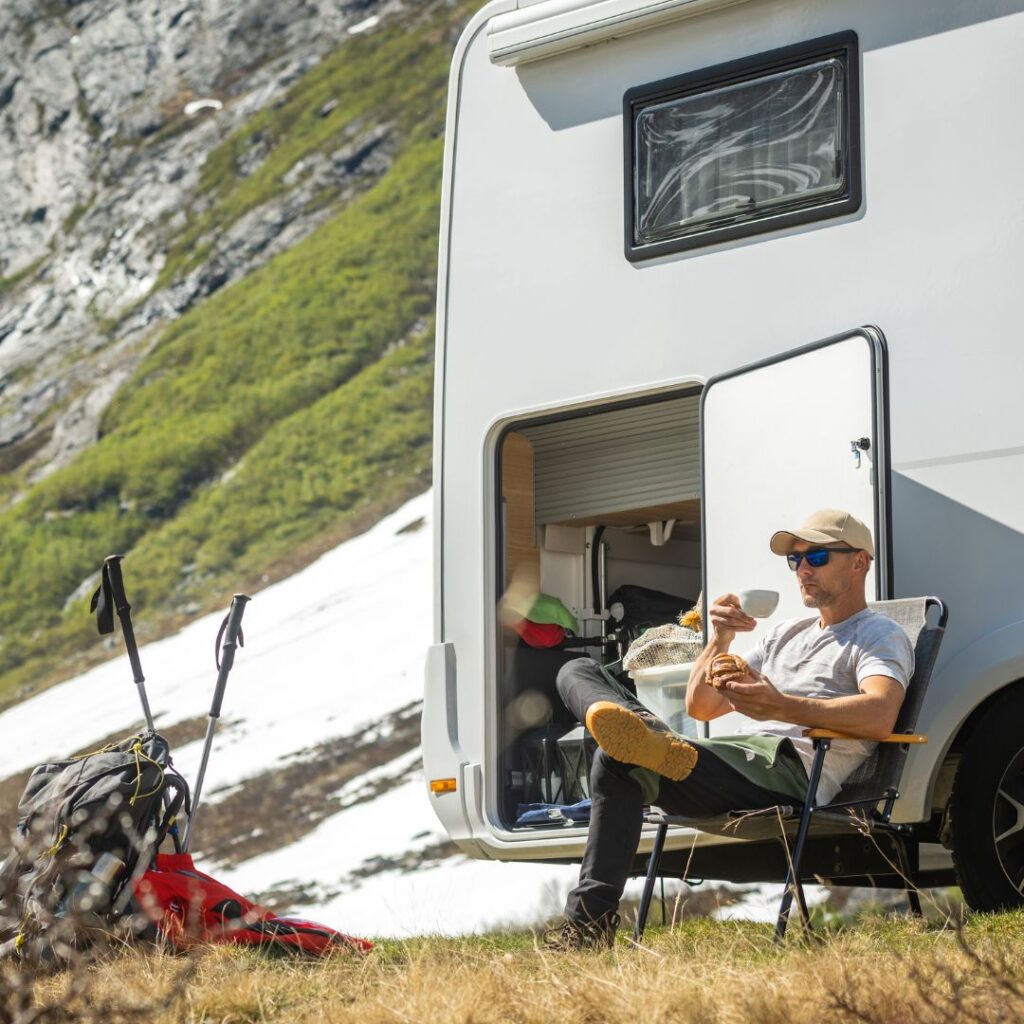What is the best way to make coffee while camping off-grid and is it possible in a solar-powered RV? Brewing coffee in a solar-powered RV, outfitted by ABC Upfitters, is completely possible – you just need to pick the right method based on your power availability. Whether you select an electric coffee maker, or prefer to use a good old-fashioned percolator, you’ll have your morning ‘pick-me-up’ wherever your travels take you.

We often hear our customers say that they are worried about sacrificing their everyday comforts when opting to use a recreational vehicle off-grid. A morning cup of coffee might recharge you, but will it drain your RV battery? There are a few challenges that come with an off-grid coffee brewing set-up, but this blog will explain the best way to make coffee while camping off-grid, and maximize your energy-efficiency when brewing.
Understand the Capabilities of Your RV Electrical System
The majority of RVs come equipped with a 1000W inverter which can power non-demanding electrical loads. Most standard drip coffee makers can draw up to 1200W which may require a shore power hookup in order to operate properly. ABC Upfitters offers fully integrated Mastervolt off-grid systems capable of powering even the most electrically demanding coffee makers. This is possible largely in part to the 3000W Combimaster inverter/charger that acts as the lifeline for your coffee maker. For example, our Borderland Package utilizes a fully integrated Mastervolt off-grid system, including a 460Ah Li-Ion battery, 3000W Combimaster Inverter/Charger, and a 25A MPPT solar charger. This package, along with several other options, give you the ability to run your RV’s electrical loads unplugged on battery power. This system gives you the ability to brew your morning coffee in the comfort of your air conditioning, completely off-grid without having to plug in! Mastervolt also offers a 3500W Combimaster which would allow you to run even more electrical loads while you brew your coffee.
Brewing Method Options
Next, you’ll select how you’ll brew your coffee – whether it is electric, manual or through a non-electric heating source.
Electric options include:
- Drip Coffee Maker – An electric standard drip coffee maker requires the most energy (around 600W-1200W)
- Single-Serve Coffee Machine – A pod-based machine like a Keurig or Nespresso (500W-1,000W)
Manual options would be a simpler gadget, like a French Press, AeroPress, or Pour-Over. This would require the user to heat water with a compatible solar water heater or an electric kettle.
The last option isn’t necessarily the best way to make coffee while camping, but if you want an option that doesn’t require solar power or battery power, you can select a non-electric heating source. The water would be heated with propane or a flame-based source and then you would proceed to make your coffee with a manual coffee maker.
With trial and error, you will learn what routine will work best for you when you’re off-grid. Read on to see what practices you can put into place to make sure you make the most sustainable, cost-efficient, and convenient cup-of-joe.
Maximizing Energy-Efficiency When Brewing
Educating yourself about your power threshold and how to optimize that level is key. Try to conserve battery life with smart power management and implement some helpful habits. The systems we install show the user real-time power consumption data via the EasyView5 touch screen display. This feature is extremely beneficial in helping you dial in your energy consumption and preservation habits. Here are some ways to optimize your routine for maximum efficiency:

- Time your coffee brewing during peak sunlight hours (usually mid-day) to maximize your incoming power from your solar panels
- Select energy-efficient manual coffee brewing methods or use low-power appliances with low-wattage.
- Brew once and keep excess coffee hot with insulated mugs or a thermos
- Use a non-electric heating source and pre-heat your water in the sun (backup for low-power days when energy is limited)
Sustainable Coffee-Making
By choosing solar power for coffee-making, travelers can enjoy their morning brew guilt-free, knowing they are reducing emissions, minimizing waste, and living a more self-sustaining lifestyle – all while enjoying the perks of the open road.
Brewing coffee with your solar equipped RV offers the convenience of off-grid freedom while eliminating the inconvenience of dealing with gas stoves or campfires. It is also a more eco-friendly and sustainable choice. Many boondockers have an appreciation for the great outdoors and want to do their part to protect nature while exploring it.
Different RV Models on the market often rely on costly gas generators that can contribute to carbon emissions. ABC Upfitters provides a product that utilizes free, renewable energy from the sun as an alternative to fossil fuels. When you use your RV to make solar-powered coffee, you’ll reduce your carbon footprint and will minimize waste. To take this a step further, there are also reusable coffee filters and compostable grounds for a cleaner, and greener alternative to traditional coffee creation.
The Best Way to Make Coffee While Camping On-The-Go
Now you know of the multiple options for creating your coveted caffeinated beverage when camping off-grid. The key is knowledge about your RV’s solar capacity and electrical system, the best ways to optimize energy efficiently, and getting creative with different routines until you find what works best for you and your traveling companions. Not only will it taste delicious, but you’ll have a sustainable and convenient way of enjoying the perfect cup of coffee, wherever your travels take you.

Check out our various package options – we promise each and every RV we upfit is equipped with a cupholder to hold your travel mug and solar-crafted latte!
You May Also Be Interested In:

Leave a Reply